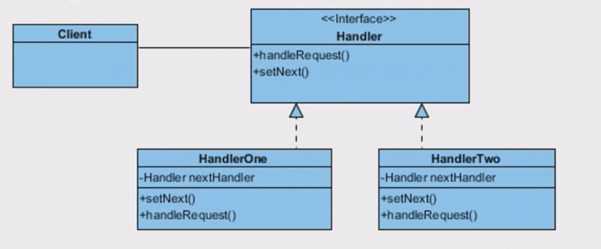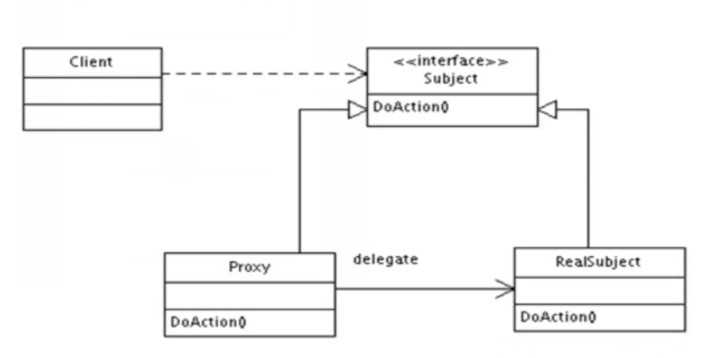用最簡單的例子說明設計模式(三)之責任鏈、建造者、適配器、代理模式、享元模式
阿新 • • 發佈:2018-05-10
def dap CA 抽象 創建 tcl cte clas eth
責任鏈模式
一個請求有多個對象來處理,這些對象是一條鏈,但具體由哪個對象來處理,根據條件判斷來確定,如果不能處理會傳遞給該鏈中的下一個對象,直到有對象處理它為止
使用場景
1)有多個對象可以處理同一個請求,具體哪個對象處理該請求待運行時刻再確定
2)在不明確指定接收者的情況下,向多個對象中的一個提交一個請求
3)可動態指定一組對象處理請求,客戶端可以動態創建職責鏈來處理請求




類適配器 原理:通過繼承來實現適配器功能。 類適配器使用對象繼承的方式,是靜態的定義方式 對於類適配器,適配器可以重定義Adaptee的部分行為,使Adaptee有了sampleOperation2() 對於類適配器,僅僅引入了一個對象,並不需要額外的引用來間接得 到 Adaptee 對於類適配器,由於適配器直接繼承了Adaptee,使得適配器不能和 Adaptee的子類一起工作
對象適配器 與類的適配器模式一樣,對象的適配器模式把被適配的類的API轉換成為目標類的API,與類的適配器模式不同的是,對象的適配器模式不是使用繼承關系連接到Adaptee類,而是使用委派關系連接到Adaptee類。 對象適配器使用對象組合的方式,是動態組合的方式 對於對象適配器,一個適配器(adaptee)可以把多種不同的源適配到同一個目標 對於對象適配器,要重定義Adaptee的行為比較困難 對於對象適配器,需要額外的引用來間接得到Adaptee。
這裏使用到編程中的一個思想:不要隨意去修改別人已經寫好的代碼或者方法,如果需改修改,可以通過代理的方式來擴展該方法。 動態代理的用途與裝飾模式很相似,就是為了對某個對象進行增強。所有使用裝飾者模式的案例都可以使用動態代理來替換。




public class Chain {
public abstract class Handler {
private Handler nextHandler;
// 當前領導能審批通過的最多天數
public int maxDay;
protected Handler(int maxDay) {
this.maxDay = maxDay;
}
//設置責任鏈中下一個處理請求的對象
public void setNextHandler(Handler handler) {
nextHandler = handler;
}
protected void handleRequest(int day) {
if (day <= maxDay) {
reply(day);
} else {
if (nextHandler != null) {
//審批權限不夠,繼續上報
nextHandler.handleRequest(day);
} else {
System.out.println("沒有更高的領導審批了");
}
}
}
protected abstract void reply(int day);
}
class ProjectManager extends Handler {
public ProjectManager(int day) {
super(day);
}
@Override
protected void reply(int day) {
System.out.println(day + "天請假,項目經理直接審批通過");
}
}
class DepartmentManager extends Handler {
public DepartmentManager(int day) {
super(day);
}
@Override
protected void reply(int day) {
System.out.println(day + "天請假,部門經理審批通過");
}
}
class GeneralManager extends Handler {
public GeneralManager(int day) {
super(day);
}
@Override
protected void reply(int day) {
System.out.println(day + "天請假,總經理直接審批通過");
}
}
public static void main(String[] strings) {
Chain chain = new Chain();
Handler projectManager = chain.new ProjectManager(3);
Handler departmentManager = chain.new DepartmentManager(5);
Handler generalManager = chain.new GeneralManager(15);
//創建職責鏈
projectManager.setNextHandler(departmentManager);
departmentManager.setNextHandler(generalManager);
//發起請假請求
projectManager.handleRequest(4);
}
}
Buidler(建造者)模式 一種創建型的設計模式.,通常用來將一個復雜的對象的構造過程分離, 讓使用者可以根據需要選擇創建過程.另外, 當這個復雜的對象的構造包含很多可選參數時, 也可以使用建造者模式
public class AlerDialog {
private String title;
private String message;
public AlerDialog(Builder builder) {
// View.inflate()
this.title = builder.title;
this.message = builder.message;
}
public static class Builder {
private String title;
private String message;
public Builder setTitle(String title) {
this.title = title;
return this;
}
public Builder setMessage(String message) {
this.message = message;
return this;
}
public AlerDialog build() {
return new AlerDialog(this);
}
}
}
new AlerDialog.Builder().setTitle("").setMessage("").build();
適配器模式: 把一個類的接口變換成客戶端所期待的另一種接口,從而使原本因接口不匹配而無法在一起使用的類能夠一起工作。 適配器就是一種適配中間件,它存在於不匹配的二者之間,用於連接二者,將不匹配變得匹配,簡單點理解就是平常所見的轉接頭,轉換器之類的存在。



類適配器 原理:通過繼承來實現適配器功能。 類適配器使用對象繼承的方式,是靜態的定義方式 對於類適配器,適配器可以重定義Adaptee的部分行為,使Adaptee有了sampleOperation2() 對於類適配器,僅僅引入了一個對象,並不需要額外的引用來間接得 到 Adaptee 對於類適配器,由於適配器直接繼承了Adaptee,使得適配器不能和 Adaptee的子類一起工作
public interface Target {
void sampleOperation1();
void sampleOperation2();
}
public class Adaptee {
public void sampleOperation1() {
System.out.println("sampleOperation1");
}
}
public class Adapter extends Adaptee implements Target {
@Override
public void sampleOperation2() {
System.out.println("sampleOperation2");
}
}
public class MyClass {
public static void main(String[] args) {
Adapter adapter = new Adapter();
adapter.sampleOperation1();
adapter.sampleOperation2();
}
}
對象適配器 與類的適配器模式一樣,對象的適配器模式把被適配的類的API轉換成為目標類的API,與類的適配器模式不同的是,對象的適配器模式不是使用繼承關系連接到Adaptee類,而是使用委派關系連接到Adaptee類。 對象適配器使用對象組合的方式,是動態組合的方式 對於對象適配器,一個適配器(adaptee)可以把多種不同的源適配到同一個目標 對於對象適配器,要重定義Adaptee的行為比較困難 對於對象適配器,需要額外的引用來間接得到Adaptee。
public interface Target {
void sampleOperation1();
void sampleOperation2();
}
public class Adaptee {
public void sampleOperation1() {
System.out.println("sampleOperation1");
}
}
public class Adapter implements Target {
private Adaptee mAdaptee;
public Adapter(Adaptee adaptee) {
mAdaptee = adaptee;
}
@Override
public void sampleOperation1() {
mAdaptee.sampleOperation1();
}
@Override
public void sampleOperation2() {
System.out.println("sampleOperation2");
}
}
public class MyClass {
public static void main(String[] args) {
Adapter adapter =new Adapter(new Adaptee());
adapter.sampleOperation1();
adapter.sampleOperation2();
}
}
代理模式 通過代理對象訪問目標對象.這樣做的好處是:可以在目標對象實現的基礎上,擴展目標對象的功能。在調用這個方法前作的前置處理(統一的流程代碼放到代理中處理)。調用這個方法後做後置處理。
這裏使用到編程中的一個思想:不要隨意去修改別人已經寫好的代碼或者方法,如果需改修改,可以通過代理的方式來擴展該方法。 動態代理的用途與裝飾模式很相似,就是為了對某個對象進行增強。所有使用裝飾者模式的案例都可以使用動態代理來替換。




/**
* subject(抽象主題角色):
* 真實主題與代理主題的共同接口。
*/
interface Subject {
void sellBook();
}
/**
* ReaISubject(真實主題角色):
* 定義了代理角色所代表的真實對象。
*/
public class RealSubject implements Subject {
@Override
public void sellBook() {
System.out.println("出版社賣書");
}
}
/**
* Proxy(代理主題角色):
* 含有對真實主題角色的引用,代理角色通常在將客
* 戶端調用傳遞給真實主題對象之前或者之後執行某些
* 操作,而不是單純返回真實的對象。
*/
public class ProxySubject implements Subject {
private RealSubject realSubject;
@Override
public void sellBook() {
if (realSubject == null) {
realSubject = new RealSubject();
}
sale();
realSubject.sellBook();
give();
}
public void sale() {
System.out.println("打折");
}
public void give() {
System.out.println("送優惠券");
}
}
public class Main {
public static void main(String[] args) {
//靜態代理(我們自己靜態定義的代理類)
ProxySubject proxySubject = new ProxySubject();
proxySubject.sellBook();
//動態代理(通過程序動態生成代理類,該代理類不是我們自己定義的。而是由程序自動生成)
RealSubject realSubject = new RealSubject();
MyHandler myHandler = new MyHandler();
myHandler.setProxySubject(realSubject);
Subject subject = (Subject) Proxy.newProxyInstance(realSubject.getClass().getClassLoader(),
realSubject.getClass().getInterfaces(), myHandler);
subject.sellBook();
}
}
public class MyHandler implements InvocationHandler {
private RealSubject realSubject;
public void setProxySubject(RealSubject realSubject) {
this.realSubject = realSubject;
}
/**
* @param proxy 指代我們所代理的那個真實對象
* @param method 指代的是我們所要調用真實對象的某個方法的Method對象
* @param args 指代的是調用真實對象某個方法時接受的參數
* @return
* @throws Throwable
*/
@Override
public Object invoke(Object proxy, Method method, Object[] args) throws Throwable {
sale();
proxy = method.invoke(realSubject, args);
give();
return proxy;
}
public void sale() {
System.out.println("打折");
}
public void give() {
System.out.println("送優惠券");
}
}
享元模式 享元的目的是為了減少不會要額內存消耗,將多個對同一對象的訪問集中起來,不必為每個訪問者創建一個單獨的對象,以此來降低內存的消耗。
public class FlyWeight {
static class MyString {
private String myChar;
public MyString(String myChar) {
this.myChar = myChar;
}
public void display() {
System.out.println(myChar);
}
}
static class MyCharacterFactory {
private Map<String, MyString> pool;
public MyCharacterFactory() {
pool = new HashMap<>();
}
public MyString getMyCharacte(String strig) {
MyString myString = pool.get(strig);
if (myString == null) {
myString = new MyString(strig);
pool.put(strig, myString);
}
return myString;
}
}
public static void main(String[] args) {
MyCharacterFactory myCharacterFactory = new MyCharacterFactory();
MyString a = myCharacterFactory.getMyCharacte("a");
MyString b = myCharacterFactory.getMyCharacte("b");
MyString a1 = myCharacterFactory.getMyCharacte("a");
MyString d = myCharacterFactory.getMyCharacte("d");
if (a == a1) {
System.out.println("true");
}
}
}
相關源碼:https://github.com/peiniwan/DesignPattern.git
用最簡單的例子說明設計模式(三)之責任鏈、建造者、適配器、代理模式、享元模式
